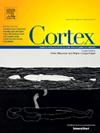逆转长期先天性失明后受损的快速神经面部分类
IF 3.3
2区 心理学
Q1 BEHAVIORAL SCIENCES
引用次数: 0
摘要
人类早期短暂的视觉剥夺对人脸的处理比对其他物体类别的处理更严重。虽然先天性视觉剥夺后视力恢复个体的面部结构加工和面部个性化似乎在很大程度上受损,但他们将刺激分类为面部的行为能力被描述为保留。在此,我们深入研究了先天性失明后恢复视力的个体快速自动面部分类。18名接受先天性白内障逆转手术的患者(6名女性,12名男性)参加了一项经过验证的脑电图(EEG)实验,该实验采用快速周期视觉刺激(FPVS)来诱导可变自然图像的自动神经面部分类反应。作为正常视力对照(N = 13)和发育性白内障逆转患者(N = 16),先天性白内障逆转患者表现出清晰的神经面部分类活动。然而,他们的神经面孔分类反应明显减弱和延迟。这些观察结果表明,以往的显性任务行为研究缺乏敏感性,无法揭示先天性白内障患者视力恢复后面部分类的改变。这表明早期经验对分类也是必要的。我们推测,面部分类的神经相关改变是由于枕侧颞叶皮层的面部选择区域选择性较低,阻碍了面部身份识别等高阶面部处理。本文章由计算机程序翻译,如有差异,请以英文原文为准。
Impaired rapid neural face categorization after reversing long-lasting congenital blindness
Transient early visual deprivation in humans impairs the processing of faces more than of other object categories. While configural face processing and face individuation appear to be largely impaired in sight recovery individuals following congenital visual deprivation, their behavioral ability to categorize stimuli as faces has been described as preserved. Here we thoroughly investigated rapid automatic face categorization in individuals who had recovered sight after congenital blindness. Eighteen participants (6 women, 12 men) who had undergone congenital cataract reversal surgery participated in a well-validated electroencephalographic (EEG) experiment with fast periodic visual stimulation (FPVS) to elicit automatic neural face-categorization responses from variable natural images. As normally sighted controls (N = 13) and individuals with reversed developmental cataracts (N = 16), congenital cataract reversal individuals exhibited clear neural face-categorization activity. However, their neural face categorization responses were significantly weaker and delayed. These observations show that previous behavioral studies with explicit tasks lacked sensitivity to uncover altered face categorization in sight-recovery individuals with a history of congenital cataracts. This indicates that early experience is necessary for categorization too. We speculate that altered neural correlates of face categorization result from a lower selectivity of face-selective areas of the ventral occipito-temporal cortex, impeding higher-order face processes such as face identity recognition.
求助全文
通过发布文献求助,成功后即可免费获取论文全文。
去求助
来源期刊

Cortex
医学-行为科学
CiteScore
7.00
自引率
5.60%
发文量
250
审稿时长
74 days
期刊介绍:
CORTEX is an international journal devoted to the study of cognition and of the relationship between the nervous system and mental processes, particularly as these are reflected in the behaviour of patients with acquired brain lesions, normal volunteers, children with typical and atypical development, and in the activation of brain regions and systems as recorded by functional neuroimaging techniques. It was founded in 1964 by Ennio De Renzi.
 求助内容:
求助内容: 应助结果提醒方式:
应助结果提醒方式:


